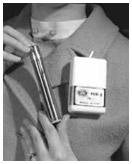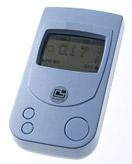Exposure Assessment Tools by Approaches - Direct Measurement (Point-of-Contact Measurement)
Overview

 Photo courtesy of Oak Ridge National Lab, U.S. DOE.
Photo courtesy of Oak Ridge National Lab, U.S. DOE.
 Photo: Dosimetrist at en.wikipedia [CC0], via Wikimedia Commons.
Photo: Dosimetrist at en.wikipedia [CC0], via Wikimedia Commons.According to EPA’s Guidelines for Exposure Assessment (U.S. EPA, 1992), direct measurement or 'point-of-contact' exposure measurement
"evaluates an exposure as it occurs, by using direct methods to measure the chemical concentrations at the interface between the person and the environment as a function of time, resulting in an exposure profile."
Point-of-contact exposure measurements are performed using personal monitoring techniques (i.e., personal air sampling or diet sampling) that record an individual’s direct exposures during a specified time period.
Provided measurement techniques are available and accurate, this method is likely to produce the least uncertainty in estimating exposure concentration, at least over the time period of the measurements.
Point-of-contact measurement, however, can be cost-prohibitive and can require extrapolation from short-term sampling to long-term exposure, thereby increasing uncertainty. Additionally, direct measurement of exposure is neither source-specific nor representative of an entire population.
Direct exposure measurements could be used to validate or verify results of assessments conducted using indirect estimation, such as scenario or population-based evaluations (U.S. EPA, 1992).
Observational human exposure studies require strict adherence to ethical guidelines. From problem formulation to study implementation, careful considerations must be taken at each step to ensure the health and safety of human subjects. Specific actions will vary depending on the type of research being conducted and characteristics of the human subjects.
Based on proceedings from an expert panel workshop, EPA’s National Exposure Research Laboratory produced The Scientific and Ethical Approaches for Observational Exposure Studies (SEAOES) (U.S. EPA, 2008). This document provides detailed information on regulatory requirements and ethical and moral issues associated with the protection of human subjects.
Methods
Personal exposure monitoring directly measures an individual’s exposure as it occurs. It can be used to measure exposure of an individual to contaminants in the breathing zone, in food and drink, and on the skin.
Many sampling techniques for personal exposure monitoring are available and continue to be developed. Considerations for choosing a monitoring technique include:
- Feasibility – Are study subjects likely to comply with the study requirements for carrying equipment or recording activities?
- Accuracy – What level of detection is required for the scenario?
- Implementation – How many subjects are needed? Are there seasonal trends in exposure that should be considered?
- Expense – How much does the sampling equipment cost? Is sample analysis inexpensive?
Often, study participants keep an activity diary to record their locations and activities while wearing the monitor. This provides the assessor with additional information to characterize potential emission sources and to better extrapolate from short-term measurements to long-term estimates.
To ensure human safety, careful steps must also be taken to ensure monitoring methods do not subject individuals to any more exposure than necessary.
Inhalation
Passive and active monitors used to measure inhalation exposure are typically compact and located close to the breathing zone of the individual. Monitors that are comfortable and make little noise encourage use among study participants. However, these constraints also limit the sophistication of the devices used and how much they can measure.
For both passive and active sampling, it is often necessary to extrapolate the absorbed dose from the measured concentration since the absorbed dose will vary depending on other factors including ventilation rate.
Passive Sampling
Passive sampling uses sorption or entrapment in a diffusion tube, badge, detector tube, or similar device. Passive sampling is often more appropriate for measuring long-term exposure rather than acute exposure since the level of detection might be higher for a passive sampling device than an active one.
For all passive sampling methods, the samples are analyzed using spectroscopy, gas chromatography, high performance liquid chromatography, or a similar method, depending on the chemicals of concern.
Diffusion badges currently are available for measurement of nitrogen dioxide (NO2), ozone (O3), sulfur dioxide (SO2), carbon monoxide (CO), and formaldehyde. Organic vapors can be measured in passive devices using activated charcoal badges.
Respirator pads inserted into respirators in place of the regular dust filters have been used to measure exposure concentrations in occupational settings.
Active Sampling
Active sampling uses a small air pump to draw air through a filter, packed tube, or similar device. Unlike passive samplers, active sampling requires electricity and moving parts.
Active monitors are available to measure particulate matter 10 micrometers and 2.5 micrometers in size (PM10 and PM2.5 ) using filters. The filter can be placed anywhere on the individual and the individual carries the pump and battery pack in a shoulder bag.
Cyclone samplers are available to measure particulates. The sampler spins the particles in an air stream, forcing them to the sides of the device for collection. Impactor and denuder filter packs can be combined to measure aerosols and gases. A diffuser tube can be coated with different materials to measure different chemicals and gases.
Ingestion
Duplicate diet studies (or duplicate portion studies) are ways to measure concentrations of a chemical of concern in the diet. In these studies, individuals collect duplicate samples of all the foods they consume during a given period.
This method can give an accurate estimate of exposures through ingestion of contaminated foods. However, it tends to be expensive to implement and requires that participants be literate and motivated to complete the study activities. Alterations in an individual’s diet and noncompliance with the study protocol can introduce bias into the intake estimates (Stockley, 1985).
Duplicate diet studies can provide direct measurements of chemical contaminants in food as well as the intake rate of various foods, typically normalized to the body weight of each participant. They can also provide information on changes in chemical concentration due to food preparation such as reductions in residues due to washing or increases in chemicals due to cooking.
Dermal
Patches, whole-body dosimeters, removal methods, and optical methods can be used to measure exposure to chemicals on the skin. Band-Aid, sticker-like patches, or gauze pads are placed on the body to collect the chemical of concern. Whole-body dosimeters are intended to measure exposure to the whole body.
Patches were first used approximately 30 years ago to investigate exposure to organophosphate pesticides (Durham and Wolfe, 1962). They have since been used for a variety of substances, including polycyclic aromatic hydrocarbons (PAHs), copper oxide, and dusts (Soutar et al., 2000).
Patches can collect personal measurements of dermal exposure to soil/sediment in a relatively easy and inexpensive manner. They can, however, miss critical areas of exposure depending on where on the body they are placed. Additionally, extrapolation from a relatively small patch to an entire body surface can introduce error.
Whole-body dosimeters are intended to measure exposure to the whole body. Examples include badges worn on the clothing, a coverall suit, and full-length cotton underwear (Federal Insecticide, Fungicide, and Rodenticide Act (FIFRA) Scientific Advisory Panel (SAP), 2007).
Removal methods include rinsing, wiping, and tape stripping to collect the contaminants of concern from the skin to be analyzed.
Optical methods involve treating the chemical of concern with a nontoxic fluorescent tracer. Video imaging is used to identify and quantify the points where the chemical contacts the skin.
Fenske et al. (1987) used fluorescent tracers to measure tetrachlorophenol exposure of nine timber workers employed at a planing mill. Tracers have also been used to study dermal exposure to pesticide applicators (Fenske, 1990; Fenske et al., 1985).
Portable x-ray fluorescence analyzers have been used to detect bromine concentrations resulting from polybrominated diphenyl ethers (PBDE) compounds emitted by consumer products from the homes of a cohort of individuals in the Great Lakes area (Imm et al., 2009).
Available Measurement Data from Personal Exposure Monitoring
There are a limited number of large measurement datasets for personal exposure monitoring. Several large datasets are listed in the table below. Other studies with smaller sample sizes are presented in the peer-reviewed literature.
Factors influencing accuracy and applicability of available measurement data include, but are not limited to, proximity to sources, activities of the studied individuals, time of day, season, and weather conditions.
Dose Estimation
Direct measurement techniques provide the assessor with chemical concentrations or amounts at the interface between the environment and an individual. This quantity can sometimes be used to estimate the potential dose to an individual.
For example, a duplicate diet study is a point-of-contact approach that attempts to quantify the amount of chemical that a person consumes, which is the potential dose for an ingestion exposure.
To estimate the applied, internal, or biologically effective dose, an assessor would need to make other assumptions regarding exposure. For example, information about the amount of chemical absorbed (e.g., across the gastrointestinal (G.I.) tract) may be needed. The disposition of the chemical following exposure – such as the chemical’s distribution or metabolism within the body – will also need to be accounted for if internal or biologically effective dose are of interest.
In general, if dose beyond the potential dose is of interest, the assessor may choose to use methods similar or identical to those described in the Indirect Estimation (scenario evaluation) approach to exposure assessment.
References
- Durham, WF; Wolfe, HR. (1962). Measurement of the exposure of workers to pesticides. Bull World Health Organ 26: 75-91.
- Fenske, RA. (1990). Nonuniform Dermal Deposition Patterns During Occupational Exposure to Pesticides. Arch Environ Contam Toxicol 19: 332-337 Exit.
- Fenske, RA; Horstman, SW; Bentley, RK. (1987). Assessment of Dermal Exposure to Chlorophenols in Timber Mills. Appl Ind Hyg 2: 143-147 Exit.
- Fenske Richard, A; Leffingwell John, T; Spear Robert, C. (1985). Evaluation of Fluorescent Tracer Methodology for Dermal Exposure Assessment Exit. In Dermal Exposure Related to Pesticide Use: American Chemical Society.
- FIFRA SAP (Federal Insecticide, Fungicide, and Rodenticide Act, Science Advisory Panel). (2007). A set of scientific issues being considered by the EPA regarding: Review of worker exposure assessment methods. Arlington, Virginia: FIFRA Scientific Advisory Panel Meeting.
- Imm, P; Knobeloch, L; Buelow, C; Anderson, HA. (2009). Household Exposures to Polybrominated Diphenyl Ethers (PBDEs) in a Wisconsin Cohort Exit. Environ Health Perspect 117: 1890-1895.
- Soutar, A. (2000). Use of Patches and Whole Body Sampling for the Assessment of Dermal Exposure. 44: 511-518 Exit.
- Stockley, L. (1985). Changes in Habitual Food Intake During Weighed Inventory Surveys and Duplication Diet Collections. A Short Review Exit. Ecol Food Nutr 17: 263-269.
- U.S. EPA. (1992). Guidelines for Exposure Assessment. (EPA/600/Z-92/001). Washington, DC.
- U.S. EPA. (2008). Scientific and Ethical Approaches for Observational Exposure Studies. Washington, DC.
- U.S. EPA. (2008). The Scientific and Ethical Approaches for Observational Exposure Studies (SEAOES).
